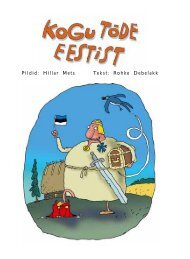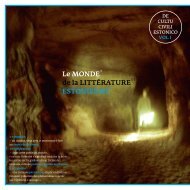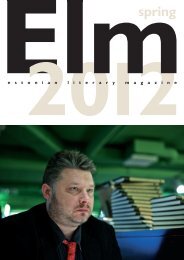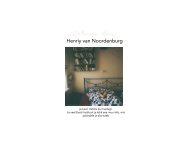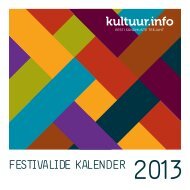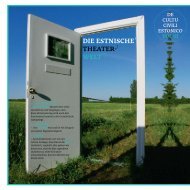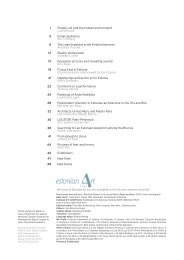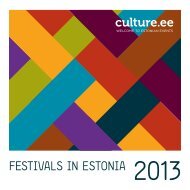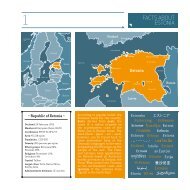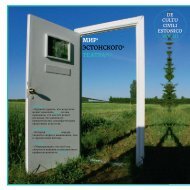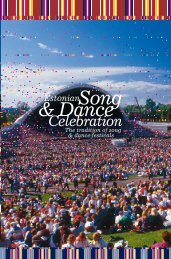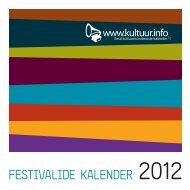Autumn 2013
Autumn 2013
Autumn 2013
You also want an ePaper? Increase the reach of your titles
YUMPU automatically turns print PDFs into web optimized ePapers that Google loves.
The last lecture of the seminar took place<br />
in the afternoon. Eneken Laanes talked about<br />
Estonian historical novels and memory literature,<br />
and how historical fiction had shaped<br />
Estonians’ views of history. The genre began<br />
with Bornhöhe’s work; the events of St<br />
George’s Uprising could have been largely<br />
invented by the author, but people accepted<br />
everything as real. A great contribution to the<br />
awakening-era historical memory was made<br />
by Kreutzwald’s epic Kalevipoeg and by<br />
Jakobson. The topics of interest at the end of<br />
the 19th century were the crusades, the arrival<br />
of the Lutheran church in Estonia, serfdom and<br />
the awakening era. This was the first era of<br />
the historical novel as a “portable monument”;<br />
the genre was essential in encouraging the<br />
emerging sense of nationality and national<br />
identity. The second era of the Estonian historical<br />
novel arrived during the years of Estonian<br />
independence, in the 1920s and 1930s, when<br />
a need emerged for masculine, successful,<br />
militant figures; the topic of Baltic Germans and<br />
Vikings was in fashion, and this was a time<br />
when historical novels were first illustrated. Still,<br />
like elsewhere in Europe, the historical novel<br />
was not the strongest genre in Estonian<br />
modernism. The historical novel in exile literature<br />
during the Soviet era centred on European<br />
topics, and recent history was treated through<br />
different approaches. The 1970s witnessed<br />
another era, where documentary novels appeared<br />
on the literary scene, along with Jaan<br />
Kross’s novels. It was possible to discuss the<br />
complicated (recent) past only at the end of<br />
the 1980s. New historical prose arrived in the<br />
1990s: historical fiction and alternative voices<br />
in literature. World War II was mostly tackled<br />
by memory literature.<br />
After the lecture, the programme became<br />
quite free. Some tormented Indrek with various<br />
translation problems, while some continued to<br />
talk about The Pilgrimage. A few brave people<br />
decided to have a swim in the sea, and some<br />
preferred a walk in the forest, where swarms<br />
of mosquitoes were happy to see that dinner<br />
was served. Some worked at their laptops,<br />
some braved the sauna, and some, i.e. definitely<br />
one, enjoyed a stretch of solitary seaside,<br />
sharing it with a fairly large fox who had captured<br />
a bird. Another cat appeared in the village,<br />
properly dressed but too shy, so photographs<br />
only captured a blurred image.<br />
On Wednesday we said farewell to<br />
Käsmu, and took the bus to Tallinn. On the<br />
way, we picked up Ott Sandrak, who guided<br />
us through the town, along “the path of<br />
Melchior”. Ott Sandrak’s knowledge of<br />
Tallinn, medieval and otherwise, is astonishing.<br />
He probably knows more about<br />
each brick than the rest of us know about<br />
the entire town. The trip was like a threehour<br />
fairy tale about medieval Tallinn,<br />
although we only walked in the lower town.<br />
We saw St Olaf’s Church, observed the<br />
different stages of construction of the town<br />
wall and saw the oldest house in Tallinn. In<br />
Rataskaevu (wheel well) Street, close to<br />
“Melchior’s house”, we learned why the well<br />
was no longer used there: a dead cat was<br />
found in it. Heaven knows whether the little<br />
creature was suicidal or whether someone<br />
helped it to carry out the project, but its<br />
death was enough to cover up the well. At<br />
the Town Hall, we were told how courts<br />
operated in the Middle Ages and what<br />
clothes the officials wore. We were lucky to<br />
see the rest of St Catherine’s Church and<br />
the Dominican monastery. Finally we ended<br />
up in Kloostri Ait, the former armoury of the<br />
town, and tucked into our lunch of duck<br />
whose days had ended unhappily.<br />
We also visited the Estonian Literature<br />
Centre’s premises on Brokusmägi. Our little<br />
group scattered in the afternoon: catching a<br />
flight, a bus or a train, but we all had<br />
experienced a very successful seminar. The<br />
days in Käsmu were full of useful talks and<br />
encouraging discussions for future work. We<br />
are all grateful to the Estonian Literature<br />
Centre for a fascinating programme.<br />
Nothing of this has found its way into<br />
historical records, as records are no longer<br />
kept. In one way or another, man’s life<br />
blends into the past like fish into water. Even<br />
if it is recorded in the chronicles. Only the<br />
fish remains. Only water.<br />
29



